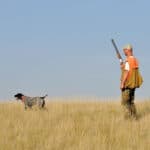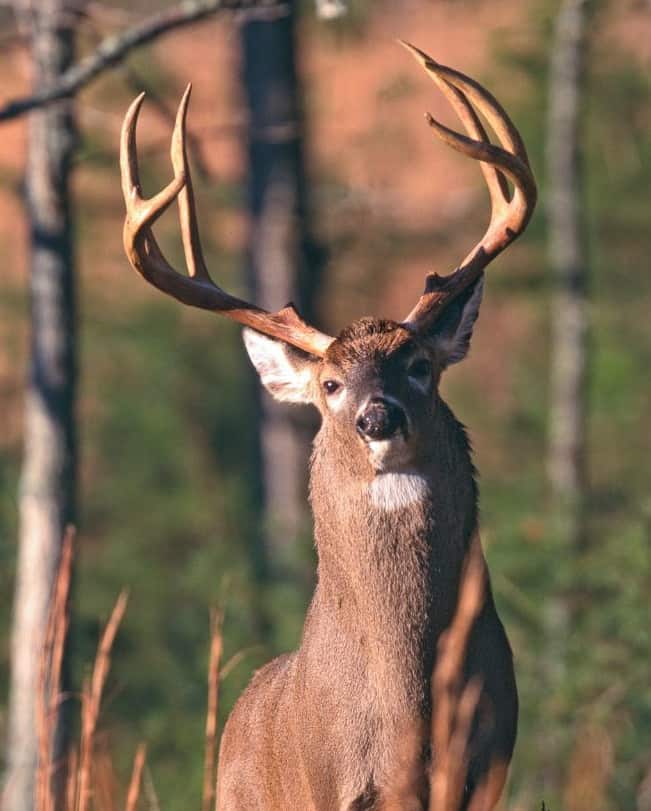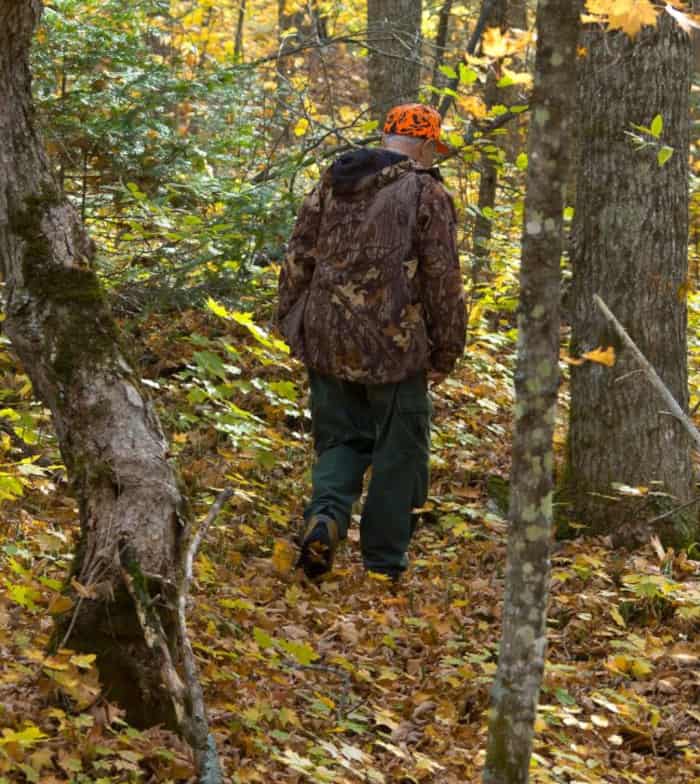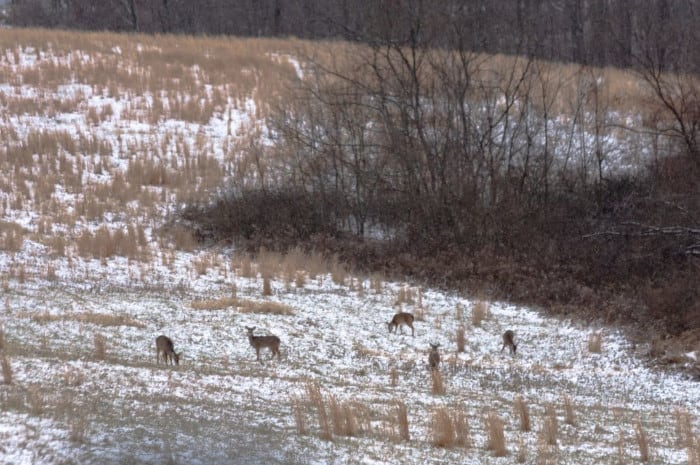Do deer decoys work? I wish I had a dollar every time I’ve heard that question asked at my day job. The answer is yes, they can, but not all the time. Under the right circumstances or conditions, whitetail decoys can be a helpful tool to lure that big buck into shooting range.
However, there are also situations where a decoy might do more harm than good. In this article, I’ll discuss how deer decoys work and provide some suggestions and guidelines for deploying them in your hunts.
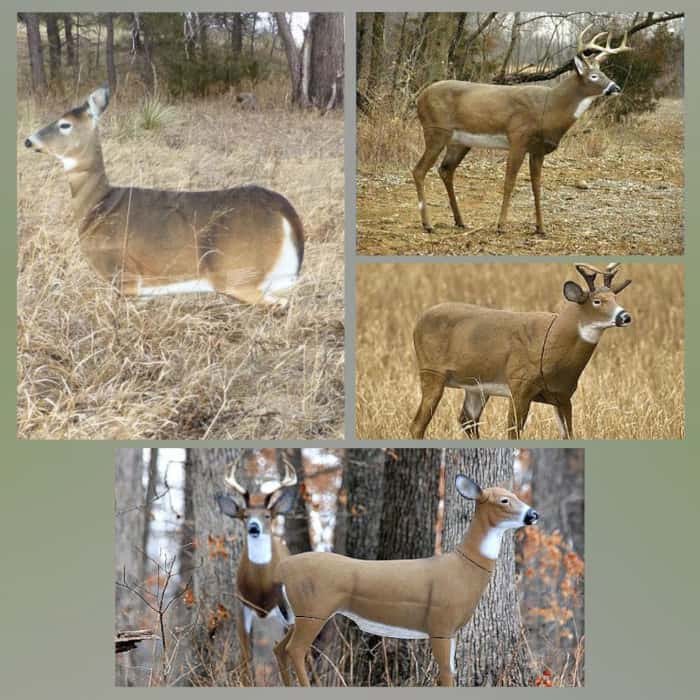
Situations When Deer Decoys Are Effective
Decoys in one form or another have been used for centuries, so the deer decoy concept is not new. But some readers may be asking: exactly what is a deer decoy?
Decoys for Deer Explained
A deer decoy is an artificial representation of a natural deer, typically used by hunters to attract deer to a specific area. These decoys are designed to appear life-like and are available in two dimensional (2D) and three dimensional (3D) configurations.
In addition, this decoy style is available in both buck and doe configurations, as there may be instances where a doe decoy is a better option than a buck decoy.
The decoys are typically made from lightweight materials such as polyethylene plastic, foam, or rubber and can be painted or built to resemble a natural deer. Decoys come in various shapes and sizes and can be either stationary or mounted on a base that allows them to move in the wind.
What Makes deer Decoys Effective?
So how can these deer decoys successfully lure bucks into shooting range?
Here are three potential reasons:
1) Whitetail bucks become increasingly competitive leading up to the mating season, making them all the more likely to investigate any other potential suitors or mating candidates.
2) They also have heightened senses during this period due to increased testosterone levels, allowing them to detect movement and certain smells even at long distances.
3) During the rut, because daylight hours are shorter later in the season, bucks are often on their feet earlier and looking for females. The biological drive to mate makes them more apt to respond to a doe decoy.
If you think that decoys don’t work or won’t work, check out this video compilation of mature bucks going after buck decoys.
I find doe and buck decoys to be the most effective under the following situations:
- During The Pre-Rut And Rut
- During The Secondary Rut
- When Bucks Are Hesitant To Come Into A Call
During The Pre-Rut And Rut
Using deer decoys during the pre-rut and rut can be an effective way to attract bucks. During this time, bucks are actively searching for does in estrous or ready to breed. So when they spot a doe decoy, it usually triggers their instinctual need to mate. This attracts them closer and gives hunters a better shot at bagging a trophy.
However, using a deer decoy isn’t always successful. If the buck is spooked by other factors, such as noise or movement from the hunter, it may not come close enough for an accurate shot. It’s also possible that a buck will ignore the decoy altogether if he has already found a doe in heat.
Hunters should consider all of these factors when deciding whether or not to use a deer decoy during this period of the deer season. However, proper placement and timing could make all the difference between success and failure in the field. While I may only use a decoy a few times a year, I’ve had good luck with decoys during the these periods.
During The Secondary Rut
Once the main mating period starts to dwindle, there will be a more minor secondary mating period called the secondary rut. This mating period predominately involves does who did not enter estrus during the primary rutting period.
While deer activity during the secondary rutting period is less active than the primary rut, this period can be another time when a decoy can pay big dividends. Bucks are still trying to mate in the secondary mating period and may come to a doe decoy or a doe and buck decoy.
When Bucks Are Hesitant To Come Into A Call
If you hunt deer long enough, you’ll encounter a situation where a big buck seems interested in your deer grunt or doe bleat, or your rattling, but not interested enough to come into range. And trust me, this is one of the most frustrating deer hunting situations you’ll encounter.
Under the right conditions, a decoy or decoy set-up, combined with some vocalizations and the occasional rattle, may be just the push he needs to come in for a closer look.
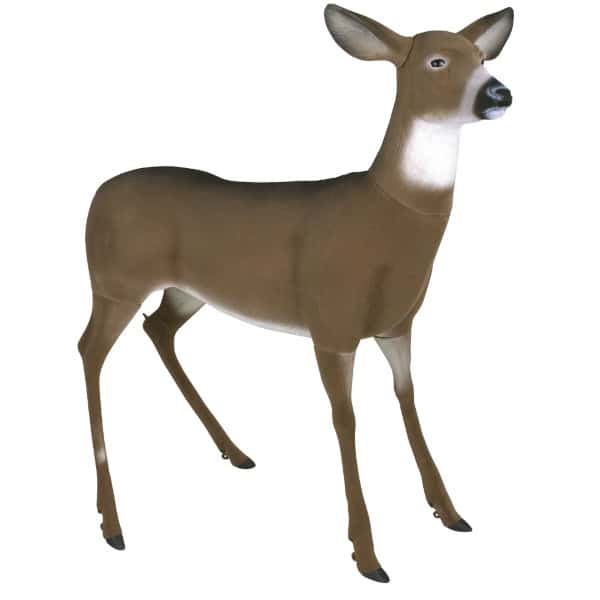
Situations When Deer Decoys Are Ineffective (And Might Drive Deer Away)
The use of deer decoys can be effective for attracting bucks, but there are certain situations when they may not work. And there are some situations or conditions where a decoy may actually scare deer away.
Let’s take a look at some common times when deer decoys might not be successful.
High Hunting Pressure Areas On Public Land
Having access to public land for deer hunting can be a blessing and a curse. Public land means that you’ll always potentially have somewhere to deer hunt, but it also means that you’ll be sharing that public land with several other hunters.
In my experience, using deer decoys on public land has two potential issues:
Safety Concerns
There are obvious safety concerns when transporting, setting up, and using a deer decoy on heavily hunted public land because you’re in the vicinity of a decoy designed to look just like a real deer.
While I haven’t personally encountered this issue, I have met and talked to hunters who had a deer decoy shot while hunting on public land.
In addition, if you have a one-piece decoy that doesn’t break down for easy transport, you’re potentially walking through woods with hunters while carrying a deer strapped to your back.
Lack of Effectiveness
Public land deer who face tremendous hunting pressure are a different breed of deer because of the pressure. As such, the pressure causes them to do things like relocate, stay in the safety of thick cover, or only move under cover of darkness.
This level of hunting pressure makes any deer, including bucks, far less willing to respond to a decoy during legal shooting hours.
For me, these factors make using a decoy on public land nearly a waste of time.
Anytime Early Season Before The Pre-Rut Begins
Early season is another period within a deer season where decoys are not practical or even advisable. Until the pre-rut period, male and female deer are focused on surviving. When the pre-rut period comes along, both sexes of deer change their habits as biology begins to kick in.
While deer are naturally curious, they are also reasonably skittish, so things out of place may make them uneasy. Seeing a doe and buck decoy close to each other at a feeder or in a field before the pre-rut phase is unusual and one example of how a deer decoy might scare deer away.
Late Season Post Rut
After the primary and secondary rut, bucks are weakened from a combination of not eating much coupled with chasing and mating. So, a mature buck, even the local dominant buck, may not want to approach a buck decoy because they don’t have the strength to fight or joust for standing.
In addition, that same mature buck is post rut so he won’t really have any interest in investigating a doe decoy either.
For those reasons, decoys don’t seem to perform very well after the rut is completely over.
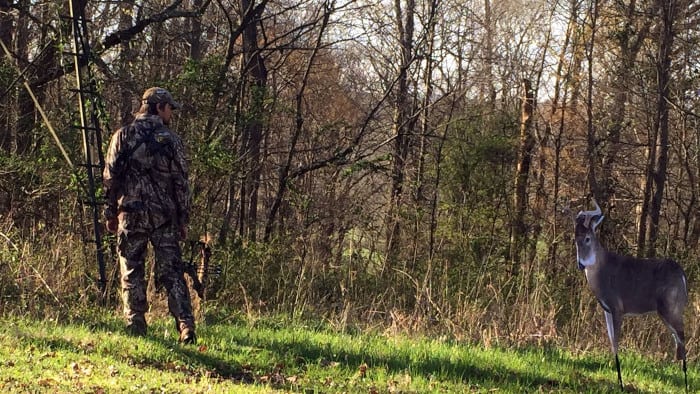
Deer Decoy Safety
No post about deer decoys will be complete without discussing safety precautions related to hunting with or over deer decoys. To ensure a safe experience when hunting with deer decoys, there are some key things to remember.
Transporting the Decoy
Without proper planning and safety in mind, transporting a decoy to a stand or hunting location can pose some risks during deer season. This is especially true if the decoy is a one-piece unit that doesn’t disassemble for transport.
I don’t recommend transporting a decoy in plain sight, especially a complete model, without it being covered. So I always carry my decoys in a carrying case or a bright orange bag. I don’t want anyone to mistake me or my decoy for a real deer.
Setting up the Decoy
Setting the decoy up or configuring it is another potentially dangerous time for a whitetail hunter, especially if they share the woods with other hunters. Therefore, I always ensure that I wear a significant amount of hunter-orange clothing or a bright orange hat during bow season when deploying deer decoys.
Buck vs. Doe Decoys – Which is Better?
The answer to the doe vs. buck decoy question is this: it really depends on the circumstances.
In some situations, like the secondary rutting period, I prefer to put both a doe decoy and buck decoy out in a decoy setup because a mature buck searching for mates may be interested in the doe or may be more interested in driving the perceived buck decoy away. In other situations, I’ll use a buck decoy alone, or a young buck decoy may be more effective in bringing in a larger mature whitetail deer.
If I had to pick one decoy during the rut, it would probably be a doe because mature male deer are biologically driven to seek out females for mating.
Common Deer Decoy Mistakes
Here are a few mistakes that I commonly see with deer decoys:
No Scent Control on the Decoy
Not applying any scent control measures to the decoy is probably one of the most common mistakes I see and one that I’ve been guilty of as well. A deer’s sense of smell is its best tool to detect danger. If your decoy was stored in your garage all year, it most likely smells like your garage.
Without some kind of scent control to eliminate the foreign smells of your garage, there’s a good chance that smell will spook the downwind deer away. Of course, I’ve made the same mistake as well. I’ve been in a hurry to get a decoy deployed in the field and completely forgot to apply any kind of scent control.
I prefer to apply sent control or deer scent directly on the decoy and on the downwind side of the decoy unit.
Decoy Position (Either Too Close or Too Far)
Another area of concern is the decoy position from a distance perspective. Ideally, you want the decoy within range for a solid shot (be it gun or bow range) but not so close that your presence or movement preparing for the shot spooks the target.
I once went rifle hunting with a buddy, and we were after meat, so we were focusing on does. We were hunting from an elevated box stand over a food plot, and he had put out a few doe decoys in an effort to make the does more comfortable coming into the field to feed.
The problem: the decoys were just over 300 yards from the stand. Now I can shoot a rifle 300 yards, but, in my mind, it would have made far more sense to place the decoys within 100 yards for an easier shot.
Leaving the Decoy in Place Too Long
Most hunters use a fixed-type deer decoy that doesn’t move, as the motion models are considerably more costly. The fixed models work fine, but they have an effective shelf life once deployed.
Let me explain: if you place a fixed deer decoy in a field and leave it for a week, the deer in the area may become suspicious as the decoy hasn’t moved in a week. Ideally, a decoy will be moved or removed within 12 hours. The 12-hour time limit is my personal limit, but I suspect the local deer start to get nervous around a decoy that doesn’t move occasionally.
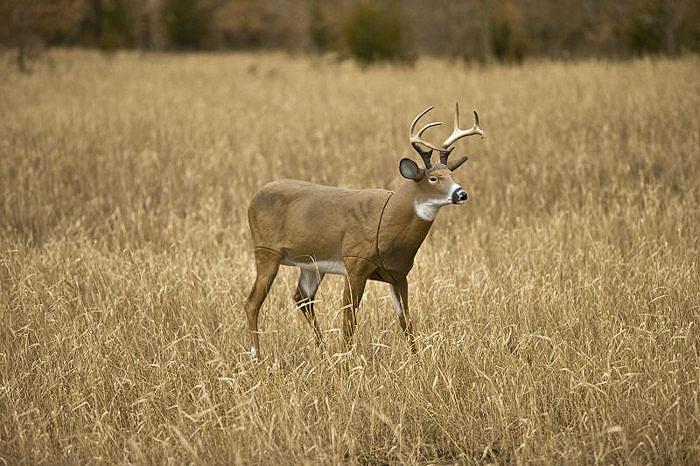
Frequently Asked Questions
Here are some commonly asked questions that I routinely see being asked about deer decoys:
Are There Any Regulations I Need To Consider When Using A Deer Decoy?
According to research, over 8 million deer decoys are sold annually in the United States alone. This massive number of sales indicates that hunters believe these devices are an effective method for attracting deer. However, before using a deer decoy, certain regulations need to be considered.
First and foremost, it’s important to check local hunting laws regarding the use of decoys. Some states may be prohibited or require special permits for use. In addition, some states have rules that forbid the use of calls with decoys or the use of decoys with calls.
How Do I Know When A Deer Decoy Is Working?
To ensure your time spent using a deer decoy isn’t in vain, here are some tips on telling if it’s working.
Firstly, pay attention to the animal’s behavior when they come within range of the decoy. If they investigate it thoroughly or even use their antlers to touch or rub against it, it may be doing its job correctly. Similarly, signs of alarm or defensive behavior might indicate that the animal senses something wrong and is wary of what lies ahead.
Another way to gauge whether a deer decoy is effective is by watching for changes in where animals feed and rest. For example, if the deer start avoiding areas near the decoy, this could mean that the decoy is not working as hoped. Additionally, observing whether there are more aggressive interactions between bucks might also suggest that one buck sees another as a potential threat because of the presence of a fake rival.
When to Use a Deer Decoy During Deer Season?
I have seen the best results using deer decoys during the two weeks leading up to the rutting period and during the rut. But, to be clear, those are just my opinions on the topic, and your own success may vary.
While I’ve had some success with a buck and doe combo decoy layout, my best results for drawing in trophy whitetails have occurred using a mature buck decoy in conjunction with buck grunts. Dominant bucks don’t like other males intruding on their turf during mating season and will come to drive the perceived rival away.
In conclusion, deer decoys can be an effective tool in whitetail hunting to attract deer or trophy buck. With proper placement and usage, you should have no problem seeing success. However, it is essential to remember that there are specific scenarios and times of the year when a decoy will be most effective.

Born and raised in Indiana, Brantley spent his youth chasing deer and turkey and, along the way, developed a passion for bowhunting. Although he still enjoys other types of hunting, his true passion is bowhunting, and he has or will author most all the bowhunting content on this site. Outside of work, Brantley is married and the father of two beautiful little girls. Brantley has worked in the hunting industry, with an emphasis on archery and bowhunting, for more than ten years.


